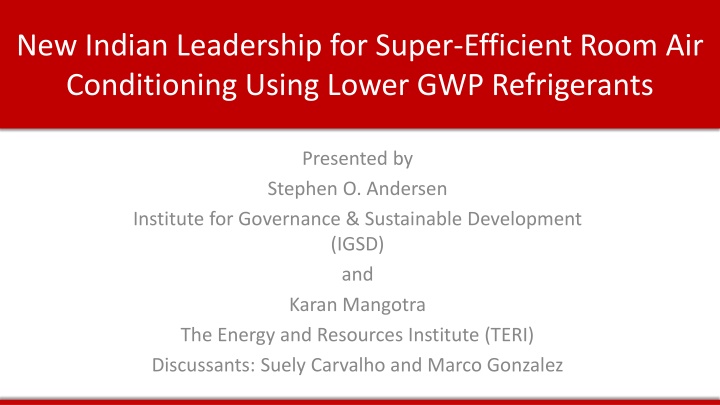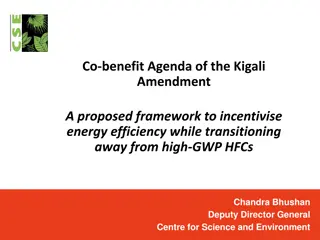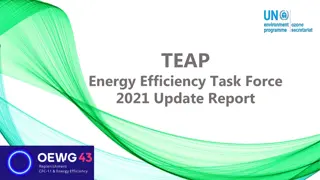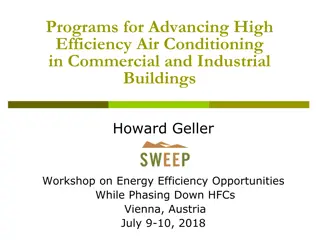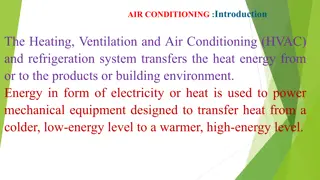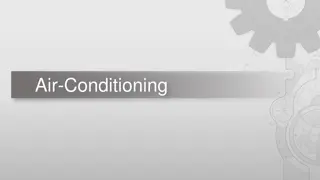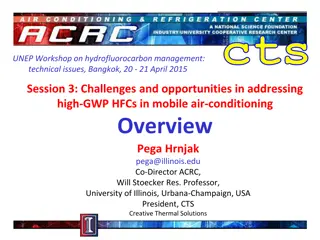Advancing Indian Leadership in Low-GWP Room Air Conditioning
This presentation highlights the rising demand for super-efficient room air conditioning in India driven by economic growth and increasing disposable income. With a significant portion of buildings yet to be constructed by 2030, the room AC market is poised for substantial growth. The imperative of energy efficiency is emphasized, with the potential for climate benefits through the transition to lower-GWP refrigerants. By focusing on efficient appliances and sustainable practices, India can lead the way in environmentally friendly cooling solutions.
Download Presentation

Please find below an Image/Link to download the presentation.
The content on the website is provided AS IS for your information and personal use only. It may not be sold, licensed, or shared on other websites without obtaining consent from the author.If you encounter any issues during the download, it is possible that the publisher has removed the file from their server.
You are allowed to download the files provided on this website for personal or commercial use, subject to the condition that they are used lawfully. All files are the property of their respective owners.
The content on the website is provided AS IS for your information and personal use only. It may not be sold, licensed, or shared on other websites without obtaining consent from the author.
E N D
Presentation Transcript
New Indian Leadership for Super-Efficient Room Air Conditioning Using Lower GWP Refrigerants Presented by Stephen O. Andersen Institute for Governance & Sustainable Development (IGSD) and Karan Mangotra The Energy and Resources Institute (TERI) Discussants: Suely Carvalho and Marco Gonzalez
The Indian Perspective Key Demand Drivers for Room AC India s GDP is growing at rate of 7.6% in 2016, which is the fastest growing large economy in the world (Standard and Poor s (S&P), the International Monetary Fund (IMF), and the Asia Development Bank (ADB) have predicted 7.5% to 8.0% growth rate of gross domestic product (GDP) for India for next two years Increase in GDP is leading to an increase in per capita disposable income; this will drive up purchasing power of individuals and their ability to afford Room ACs - leading to an increase in demand
Key Demand Drivers for Room AC Around 66% of buildings that will exist in India in 2030 are yet to be constructed (as per BEE reports) the bulk of the cooling demand would therefore be driven from the room AC segment (predominantly split) with an average of 1.35 TR (4.75 kW) There is an average increase in ambient temperature in India leading to higher demand for more cooling Currently Room ACs account for nearly 60%- 70% of total refrigerant gas market share. This segment, along with chillers will increase to a total share of nearly 80% of total refrigerant gas market by 2040 66% - 70%
Energy Efficiency is Imperative Given such a growth in buildings, and demand for appliances for cooling, it is essential that energy efficiency is incorporated as an essential feature of transition to a lower GWP pathway During the life cycle of a product, EE is expected to reap high climate change benefits during the refrigerant transition phase (HFC phasedown period) In 2015, five star rated ACs accounted for 25% of the total AC share with a 57% majority rated as 3 star Of all ACs in 2015, HCFC ACs account for 69% of the total market share and HFC ACs account for nearly the remaining market share (a)If all HCFCs and HFCs will be phased down in India and be replaced with new HFC alternatives by 2030s, the transformation in the AC segment will be huge (b)In addition, if lower-GWP refrigerants are implemented in super-efficient appliances, the total climate benefits will be enormous Air Conditioner (Share of star rated appliances) 1 2% 5 2 25% 15% 4 1% 3 57% Share of Room ACs by Type of Refrigerant Gas (2015) Others, 1% R-32, 6% R-410a, 24% HCFC-
Breaking News! Super-Efficient Room AC Lowers Ownership Cost, Avoids New Power Plants, Cleans Air, Lowers Health Care Costs, and Protects Agricultural and Natural Ecosystems Room ACs Sold by Multinational Companies in A-5 Parties are Typically Less Efficient Than the ACs Sold by the Same Companies in Their Home Countries Despite Stronger Super-Efficiency Cost Effectiveness in Most A5 Parties Due to Long, Hot and Humid Cooling Seasons New Research In Brazil Confirms This The Clean Energy Ministerial Calls on Stakeholders to Commercialize Affordable Super-Efficient Cooling Technology
The Clean Energy Ministerial (CEM) The CEM is a Global Forum to Promote Policies and Share Best Practices to Accelerate the Global Transition to Clean Energy Member Nations Are: Australia, Brazil, Canada, Chile, China, Denmark, the European Union, Finland, France, Germany, India, Indonesia, Italy, Japan, Korea, Mexico, Norway, Russia, Saudi Arabia, South Africa, Spain, Sweden, the United Arab Emirates, the United Kingdom, and the United States. The CEM Advanced Cooling Challenge (AC Challenge) Inspires: governments, companies, and other stakeholders to develop and deploy at scale super-efficient, smart, climate-friendly, and affordable cooling technologies that are critical for prosperous and healthy societies
TERI/IGSD Response to AC Challenge! Dr. Ajay Mathur (Director General TERI) and Dr. Stephen O. Andersen (Director of Research, IGSD) will co-chair a small committee of Indian and global experts and partner organizations to align public and private energy efficiency programs and advocate projects and to Kick-Start commercialization of Super-Efficient Room AC The committee will depend on the participation of experts from the Bureau of Energy Efficiency (BEE), Collaborative Labelling and Appliance Standard Program (CLASP), Energy Efficiency Services Limited (EESL), Natural Resources Defense Council (NRDC), Super- Efficient Appliance Deployment (SEAD), and other notable organizations. Dr. Suely Carvalho (former Director United Nations Development Programme - UNDP), Marco Gonzalez (former Executive Director of the Montreal Protocol Ozone Secretariat), and Rajendra Shende (Chairman of TERRE Policy Centre - TERRE - and former Director United Nations Environment Programme - UNEP) have already offered to serve. The ambition is to complete the alignment within six months in order to make Super- Efficient room ACs both cost effective for owners and profitable to companies who respond to the AC Challenge (see details in the next slide)
Daikin Response to AC Challenge! Daikin Air-Conditioning India Pvt. Ltd. (Daikin India), confirmed that they will offer an affordable super-efficient room AC using lower-GWP refrigerant HFC- 32 as soon as public and private energy efficiency programs are aligned The Daikin India ambition is to market a 5.2 ISEER* inverter room AC with HFC-32 refrigerant with a price that is 12% to 15% lower than the current retail price of premium 4.5 ISEER** variable speed ACs * A 5.2 ISEER room AC would earn 7-Stars (if the scale went that high) ** A 4.5 ISEER room AC is the lowest efficiency now qualifying for 5-Stars ISEER (Indian Seasonal Energy Efficiency Ratio) is the ratio of the total annual amount of heat that the AC equipment can remove from the indoor air to the total annual amount of energy consumed by the equipment during the same period. The calculation method is based on ISO16358, adjusted for higher typical ambient temperatures in India
Just What is This Alignment? The Alignment is to bridge communication gaps and find synergy among climate, energy, and procurement authorities in India and to put forward proposals for funding super-efficiency using lower-GWP refrigerants Specifically: Agree to a metric for appropriately considering safety, energy efficiency and refrigerant GWP and emissions in procurement criteria, Validate the energy performance of of super-efficient room AC using lower-GWP refrigerants at the full range of ambient temperatures, Organize federal and state procurement to require lower-GWP refrigerants and to insist on highest affordable energy efficiency, and Advocate making affordable super-efficient room ACs using lower-GWP refrigerants available in all A5 Parties
The Complementary TERI / IGSD Team TERI is a leading think tank dedicated to sustainable development of India and the Global South From its founding in 1974, TERI has made a mark as a research institute, whose policy and technology solutions transformed people's lives and the environment IGSD promotes and protects the environment by advancing the understanding, development, and implementation of effective, and accountable systems of governance for sustainable development For the past decade, IGSD has concentrated on reducing the uses of short- lived climate pollutants (SLCPs), including HFCs, and particularly on the synergy of HFC phase down and transition to super-efficiency
Power and Energy Service Companies Are Part of the Solution! Energy Efficiency Services Ltd. (EESL) under the Indian Ministry of Power can do a bulk procurement of super-efficient room ACs using lower-GWP refrigerants and could transfer them to power companies to sell to consumers, with the power distribution companies paying EESL back from the calculated savings It can be imagined that a portion of a bulk procurement in India could be offered for sale in adjacent countries with compatible electricity voltage/cycles and with appropriate installation and service infrastructure
